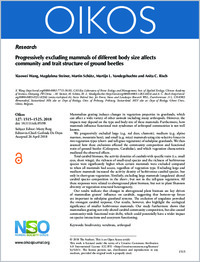Progressively excluding mammals of different body size affects community and trait structure of ground beetles
- Wang, Xiaowei Chinese Academy of Science Key Laboratory of Forest Ecology and Management, Institut of Applied Ecology, Shenyang, China
- Steiner, Magdalena Swiss Federal Institute for Forest Snow and Landscape Research, Birmensdorf, Switzerland - Department of Biology, University of Fribourg, Switzerland
- Schütz, Martin Swiss Federal Institute for Forest Snow and Landscape Research, Birmensdorf, Switzerland
- Vandegehuchte, Martijn L. Swiss Federal Institute for Forest Snow and Landscape Research, Birmensdorf, Switzerland - Department of Biology, Ghent University, Belgium
- Risch, Anita C. Swiss Federal Institute for Forest Snow and Landscape Research, Birmensdorf, Switzerland
-
01.10.2018
Published in:
- Oikos. - 2018, vol. 127, no. 10, p. 1515–1525
English
Mammalian grazing induces changes in vegetation properties in grasslands, which can affect a wide variety of other animals including many arthropods. However, the impacts may depend on the type and body size of these mammals. Furthermore, how mammals influence functional trait syndromes of arthropod communities is not well known. We progressively excluded large (e.g. red deer, chamois), medium (e.g. alpine marmot, mountain hare), and small (e.g. mice) mammals using size-selective fences in two vegetation types (short- and tall-grass vegetation) of subalpine grasslands. We then assessed how these exclusions affected the community composition and functional traits of ground beetles (Coleoptera, Carabidae), and which vegetation characteristic mediated the observed effects. Total carabid biomass, the activity densities of carabids with specific traits (i.e. small eyes, short wings), the richness of small-eyed species and the richness of herbivorous species were significantly higher when certain mammals were excluded compared to when all mammals had access, regardless of vegetation type. Excluding large and medium mammals increased the activity density of herbivorous carabid species, but only in short-grass vegetation. Similarly, excluding large mammals (ungulates) altered carabid species composition in the short-, but not in the tall-grass vegetation. All these responses were related to aboveground plant biomass, but not to plant Shannon diversity or vegetation structural heterogeneity. Our results indicate that changes in aboveground plant biomass are key drivers of mammalian grazers’ influence on carabids, suggesting that bottom–up forces are important in subalpine grassland systems. The exclusion of ungulates provoked the strongest carabid response. Our results, however, also highlight the ecological significance of smaller herbivorous mammals. Our study furthermore shows that mammalian grazing not only altered carabid community composition, but also caused community-wide functional trait shifts, which could potentially have a wider impact on species interactions and ecosystem functioning.
- Faculty
- Faculté des sciences et de médecine
- Department
- Département de Biologie
- Language
-
- English
- Classification
- Biological sciences
- License
-
License undefined
- Identifiers
-
- RERO DOC 323321
- DOI 10.1111/oik.05198
- Persistent URL
- https://folia.unifr.ch/unifr/documents/307209
Statistics
Document views: 111
File downloads:
- pdf: 138
